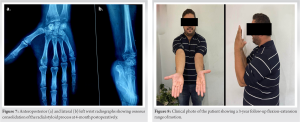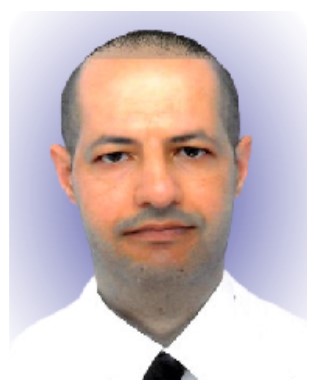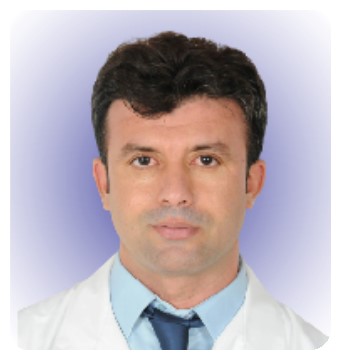Diagnostic and therapeutic particularities of divergent elbow dislocation associated with ipsilateral forearm fractures, requiring different techniques and procedures performed at the same time, in the same limb.
Dr. Amir Mhiri, Department of Orthopaedic Surgery, Sahloul Hospital, Sousse, Tunisia. E-mail: amirmhiri1@gmail.com
Introduction: The divergent elbow dislocation represents a rare lesion where the proximal radioulnar joint is torn and the distal part of the humerus goes between the radius and the ulna, the forearm dislocates posteriorly.
Case Report: We report the case of a 37-year-old male patient who had a traumatic divergent dislocation of the left elbow, associated with ipsilateral fractures of the ulnar diaphysis and the radial styloid process. The elbow joint was reduced under general anesthesia with internal fixation of the ulnar diaphysis fracture and a pinning of the radial styloid fracture. At 3 years of follow-up, the fractures were consolidated and the elbow was stable with a satisfying mobility.
Conclusion: The aim of our case report is to underline the diagnostic and therapeutic challenges of this complex lesion.
Keywords: Elbow dislocation, forearm, fracture, radio-ulnar joint, ulna.
Traumatic divergent elbow dislocation is a rare injury usually occurring in children, an adult case is very rare. We identified a few previously published case reports of divergent elbow dislocations in adults [1, 2, 3]. The first divergent elbow dislocation was described by Delee in 1981 in a case of a 6-year-old boy [4]. In 2003, Moritomo et al. described the first report of divergent dislocation in adults [5]. It was an unusual complication of the Sauve-Kapandji procedure in patients with rheumatoid arthritis. The association of divergent elbow dislocation to other ipsilateral forearm fractures is very rare. Therefore, the aim of our case report is to underline the diagnostic and therapeutic particularities of this uncommon complex lesion.
A 37-year-old man, right-handed driver, presented to the emergency department for a closed trauma of his left upper extremity after landing on the wrist with an out-stretched elbow following a fall. 


The previously reported cases of transverse divergent dislocations of the elbow occurred in children [6, 7]. Elbow dislocations are usually associated with fractures around the elbow joint such as epicondylar fractures, radial head fractures, or coronoid fractures. Kazuki et al. [1] reported on a case of traumatic divergent fracture dislocation of the elbow combined with Essex-Lopresti lesion in an adult 41-year-old man, where the radial head and the coronoid process were fractured. Casstevens et al. [2] published another case report involving an adult in 2012, distal part of the humeral shaft fracture and an open perilunate dislocation were associated. However, elbow dislocations with concurrent fractures of both the ipsilateral radius and ulna are very rare. Greene et al. [3] reported a case of a 49-year-old man who sustained a traumatic avulsion injury of the distal side of the left forearm. The radiographs showed a divergent elbow dislocation associated with an ipsilateral ulnar shaft fracture. The reconstruction of the ulnohumeral joint was the chosen therapeutic option to ensure a stable elbow flexion, extension, and prosthetic fitting. The mechanism of injury that produces dislocations of the posterior part of the elbow begins by unlocking the intrinsic stability with extreme supination of the forearm as the body rotates in an internal direction relative to the fixed extremity [8]. Cooperatively, the patient may have rupture or avulsion fracture of the medial collateral ligament or medial epicondyle [9]. In contrast to this mechanism, we hypothesize that the fracture of the ulnar shaft caused rotational instability of the elbow in our patient. This instability may have allowed interposition of the distal part of the humerus between the radius and ulna, and disruption of the proximal radioulnar joint. The essentials of managing such a complex elbow injury are restoration of joint congruity, bone stabilization as well as ligamentous reconstruction with careful manipulating of soft tissues around the elbow joint. Considerable injury to soft tissues including the interosseous membrane during this type of dislocation could result in the development of compartment syndrome [10].
Elbow dislocation with ipsilateral ulnar shaft and radial styloid process fractures is rare. A considerable force must be applied to cause this pattern of injury. Our case focuses on the point that in every elbow dislocation case, the wrist joint and the forearm need to be evaluated both clinically and radiologically. The radiographs of an elbow injury case should always include that of the wrist and vice versa. The acceptable 3-year clinical and radiographic outcomes indicate that this approach was an effective treatment for this case of divergent elbow dislocation that was associated with ulnar shaft and radial styloid process fractures.
Elbow dislocation, associated with ipsilateral ulnar shaft and radial styloid process fractures in adult, is a rare complex lesion that requires a surgical treatment and a long-term physical therapy to obtain satisfying clinical and radiological outcomes.
References
- 1.Kazuki K, Miyamoto T, Ohzono K. A case of traumatic divergent fracture-dislocation of the elbow combined with Essex-Lopresti lesion in an adult. J Shoulder Elbow Surg 2005;14:224-6. [Google Scholar]
- 2.Casstevens EC, Calfee RP, Stern PJ. Traumatic divergent elbow dislocation in an adult with an associated fracture of the distal part of the humeral shaft and an open perilunate dislocation: A case report. JBJS Case Connect 2012;2:e61. [Google Scholar]
- 3.Greene RM, Bader JE, Mauter L, Sears BW, Tirre CJ, Hatzidakis AM. Traumatic divergent elbow dislocation with associated forearm amputation in an adult: A case report. JBJS Case Connect 2018;8:e92. [Google Scholar]
- 4.DeLee JC. Transverse divergent dislocation of the elbow in a child. Case report. J Bone Joint Surg Am 1981;63:322-3. [Google Scholar]
- 5.Moritomo H, Izawa K, Murase T, Hashimoto H, Goto A, Masatomi T. Spontaneous divergent elbow dislocation after Sauve-Kapandji procedure. Clin Orthop Relat Res 2003;406:97-102. [Google Scholar]
- 6.Wu Y, Jiang H, Miao W. A case report of children’s divergent dislocation of the elbow and review of literature. Medicine (Baltimore) 2016;95:e4772. [Google Scholar]
- 7.Zaricznyj B. Transverse divergent dislocation of the elbow. Clin Orthop Relat Res 2000;373:146-52. [Google Scholar]
- 8.Deutch SR, Jensen SL, Olsen BS, Sneppen O. Elbow joint stability in relation to forced external rotation: An experimental study of the osseous constraint. J Shoulder Elbow Surg 2003;12:287-92. [Google Scholar]
- 9.Van Wagenberg JM, van Huijstee PJ, Verhofstad MH. Pediatric complex divergent elbow dislocation. J Orthop Trauma 2011;25:e5-8. [Google Scholar]
- 10.Altuntas AO, Balakumar J, Howells RJ, Graham HK. Posterior divergent dislocation of the elbow in children and adolescents: A report of three cases and review of the literature. J Pediatr Orthop 2005;25:317-21. [Google Scholar]












